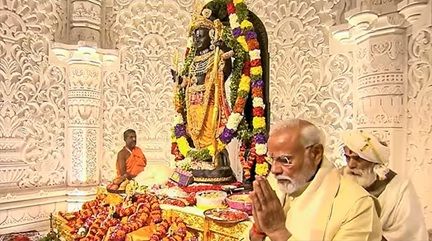As Ayodhya geared up for the momentous celebration embedded in the nation’s heritage, the SIS Group contributed to the grand tapestry of the consecration of the Ram Mandir, intertwining threads of technological innovation, unwavering commitment, and deep reverence for history.
In an Exclusive Story, SECURITY TODAY details how the SIS Group Enterprises, a prominent multinational security and allied services organisation, collaborated with the state law enforcement apparatus to flawlessly execute the Ram Mandir Pran Pratishtha ceremony in the esteemed presence of Prime Minister Narendra Modi on January 22, 2024.
As a USD 1.3 billion Indian multinational, SIS Group Enterprises holds a prominent position as a market leader in essential service verticals, encompassing Security, Facility Management, and Cash Logistics Solutions across India, Australia, Singapore, and New Zealand. Notably, it is the largest in Security Solutions and Facility Management, and the second-largest provider of Cash Logistics Solutions in India, employing a vast workforce exceeding 280,000 personnel. SIS India has consistently expanded its offerings to meet the diverse demands of the markets it serves, including catering to marquee clients that feature Fortune 200 companies.
Despite India’s significant progress in establishing modern economic infrastructure since gaining independence, the importance accorded to religion surpasses that of many other domains. According to the 2011 census, the country boasts approximately 3.01 million places of worship, outnumbering schools and colleges. Now there are likely to be many more. This translates to one place of worship for every 400 people, surpassing the collective nationwide presence of educational and medical institutions. The prevailing trend indicates that this pattern is unlikely to shift soon. India’s religious diversity is evident in the multitude of temples, mosques, churches, gurudwaras, synagogues, and other places of worship.
It is undeniable that a huge number of Indians regularly visit places of worship, whether on a daily, weekly, or festive basis. Interestingly, religious visits emerge as the second most common reason for travel, following social visits. The legendary city of Ayodhya, popularly identified as the present-day Ayodhya, is known as the birthplace of the Hindu deity, Lord Rama, and is the setting of the great epic Ramayana. It has been regarded as the first of the seven most important pilgrimage sites for Hindus. It is here that on the 22nd January 2024, at the newly built Shri Ram ‘Janmabhoomi’ (birth place) Temple in the presence of Prime Minister Narendra Modi that the Pran Pratishtha ceremony, along with thousands of devotees and high profile guests was performed. The daily tourist count is expected to be around 2 to 3 lakh per day, surpassing every city in the world!
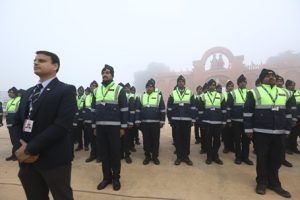
Ensuring security and safety of all attendees is not easy. Protecting religious places that hold significant cultural and symbolic value, and where thousands gather for an event is always challenging. While large-scale religious events present local governments with various valuable opportunities, such as boosting revenue, rejuvenating urban areas, and fostering a stronger sense of community, they become potential targets for those seeking to make a statement or create fear. This heightened significance attracts both domestic and international attention, a fact that was evident, with more than 19 million live views “Ram Lalla’s Pran Pratishtha” on Prime Minister Narendra Modi’s YouTube channel received and broke all previous records for the most views of any live stream on the platform. The ramifications of the occurrence of an adverse incident at such an gathering would have been catastrophic for the nation!
The risks to places of worship encompass many components, such as the safety of the congregation from acts of terrorism and extremism – crowd-related incidents such as stampedes, crushes, or structural failures – civil unrest and communal tensions – natural disasters – health emergencies – fire hazards and transportation challenges in ensuring the safe arrival and departure of all attendees, especially when the attendees are high profile, as in case of the recent event in Ayodhya where Prime Minister Narendra Modi was present along with thousands of devotees and special invitees which included the who’s who of India such as business tycoons Mukesh Ambani, Gautam Adani, N. Chandrasekharan, and superstar actors Amitabh Bachchan, Hema Malini, Vicky Kaushal and sporting legends Sachin Tendulkar, Saina Nehwal among other celebrities and scores of top politicians and spiritual leaders.
Preparations: Essential to Success
Security and worship had to be successfully blended for those who visited. To mitigate these risks, comprehensive security measures were taken.
A multi-layered security plan ahead of the event, with over a 13,000 force, including special sniper teams from the National Security Guard (NSG), a counter-terrorism unit of India, anti-bomb and dog squads had been deployed. Anti-mine drones were also present to inspect the ground for mines or explosives in Ayodhya to ensure security.
The three-layered security cordon- manned by the Special Security Force (SSF), a dedicated force set up by Uttar Pradesh government to guard temples and vital installations along with other central and local police forces protected the grand Ram Lalla temple in Ayodhya. Over the past 2-3 months SSF personnel had been trained in anti-terror tactics and intervention techniques. Other skills imparted included reflex and precision firing with assault rifles, MP5 guns and pistols, and counter-IED techniques.
Mr. Prashant Kumar, DG (Law and Order), said that besides the 13,000 forces deployed, cops are using artificial intelligence-powered CCTV to improve the security system in Ayodhya. As many as 10,000 CCTV cameras have been installed across Ayodhya for 24×7 monitoring ahead of the ‘Pran Pratistha’. There are drones and also anti-drone (C-UAS) technology being used. Movable barriers with barbed wire have been placed at every crossroad in Ayodhya, which cops use to regulate traffic, especially during VVIP movements.
However, the successful implementation of the security and safety plans for Ayodhya would not have been possible without the support of the Private Security Industry.
Private Security: Vital Support
Amidst all this, private security solutions giant, SIS Group, stepped in to assist the police and the state administration in securing and managing the flow of visitors to ensure error free execution of the mega event.
In the progressive economies of the world, all state security forces function with the ancillary support of the private security industry – whether its services or supply of technology to discharge their duties. While safety and security, especially during mega and high profile events is their responsibility, the state machinery falls back on the private sector for support where needed.

Mr. Laique Ahmed, Regional Vice President – Uttar Pradesh Region disclosed that their team was interacting regularly with the district administration, law enforcement, and the senior members of the Shri Ram Janmabhoomi Mandir Trust, to synergise all operations. While the overall security responsibility was that of police, SIS complemented the police security by providing valuable Human Intelligence (HUMINT) and Tech-Intelligence by integrating the CCTV cameras with our Artificial Intelligence (AI) based software.
Collaboration between state security forces and private security is vital for securing high-profile events. Private security brings specialised skills, advanced technology, and flexibility to complement state forces. Their expertise in areas like crowd control and event-specific planning enhances overall security measures. This partnership fosters efficiency, cost-effectiveness, and a proactive approach to risk management, creating a well-rounded security framework for the successful execution of high-profile events.
Planning: The Foundation
Effective planning is the compass that guides us through the complexities of the present, empowering us to navigate confidently towards the possibilities of the future.
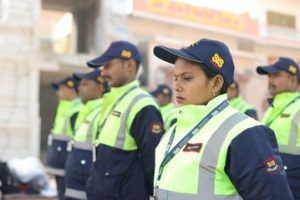
The role of planning in securing a mega event cannot be overstated; it is paramount. Planning serves as the bedrock for a comprehensive security strategy, ensuring that all aspects of the event are considered, potential risks are identified, and appropriate measures are put in place. From crowd management and emergency response to fire safety and counterterrorism efforts, a well-thought-out plan provides the framework for coordinated and effective security measures.

In an exclusive conversation with SECURITY TODAY, Brig. Rajesh Chandra Dwivedi (Retd.), Executive Director of SIS Security in the Uttar Pradesh Region, provided an overview of the project. He revealed that in April 2023, a team from SIS Security visited the Shri Ram Mandir in Ayodhya and presented their plans to the Shri Ram Janam Bhoomi Trust. Following this discussion, a survey was conducted, and an initial deployment plan was proposed. In May of the same year, the client officially requested SIS Security to initiate deployment. Following a comprehensive planning phase, 45 security personnel, including female security guards, were initially deployed after receiving site-specific training. During the recent Pran Pratishtha ceremony, the number of on-duty security personnel increased to over 300.
Training: The Cornerstone
Training is crucial in the security profession as it ensures personnel are equipped with requisite skills. Training encompasses observation skills, communication skills, technological skills to operate security gadgets, threat identification, crowd control, threat assessment, and emergency response, intelligence gathering, crisis management techniques, and event-specific knowledge enhancing the ability to handle unique challenges.
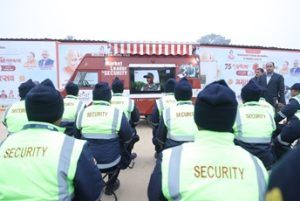
Once again, SIS Group stands out as a prominent leader in this domain. The identification and subsequent development of talent through training and robust HR practices stand as key pillars behind its success.
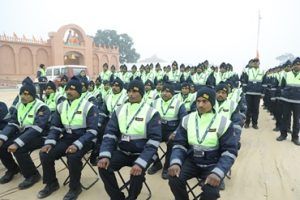
In addition to standard training, each team member undergoes training tailored to the client and site, accompanied by a Standing & Post Instructions (SPI) checklist. This checklist outlines key instructions for specific assignments, serving to both summarise the ‘do’s and don’ts’ and streamline customer-centric services.
With the largest number of government-approved training academies in the private security industry in India, precisely 19 academies across 14 states, SIS Group offers fundamental training that aligns with national occupational standards for new recruits, and is in accordance with the stipulations of the Private Security Agencies Regulation Act.
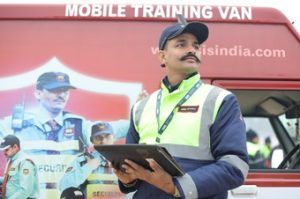
A well-trained private security force enhances collaboration with state forces, fostering a seamless and coordinated security approach. Their expertise and readiness play a crucial role in mitigating risks and ensuring the safety and success of significant events, as exemplified by the recent one in Ayodhya.
Upon successful completion of training, all security personnel are assigned to various client sites based on their rank/designation and job suitability. Subsequently, ongoing training is consistently conducted through SIS Group’s innovative mobile training platform, ‘MTrainer,’ where the ‘classroom’ is brought directly to client sites—a pioneering initiative in the security industry!
The mobile training platform, MTrainer, facilitates continuous on-the-job training in various areas such as fire safety, searching and frisking, mob control, access control, and vehicle management. This training is accessible across India through training vans, tablets, and mobile phones. M-Trainer’s learning modules can also be customised based on the specific requirements of clients.
“SIS Group was entrusted with the responsibility not only to bolster the existing police force in security but also to serve as facilitators or ‘sewadars,’ providing essential comforts to all devotees. We oriented our team to perform duties with ‘Shardha Bhav’ and politeness, while maintaining firmness in matters of security and safety. Our staff underwent training to assist the infirm and those on wheelchairs requiring support,” Brig. Dwivedi revealed.
In addition to assisting visitors in various capacities, SIS efficiently managed the locker area since mobile phones and smartwatches were prohibited inside for security reasons. They also played a role in operating baggage X-ray scanners, handling lost and found articles, and managing queue systems.
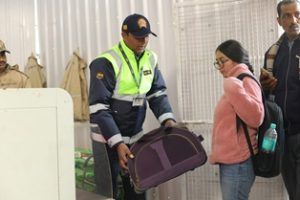
Given the demanding nature of the task, our team approached it with utmost professionalism, providing the necessary skills and training to all involved. Monthly coordination and liaison meetings were conducted with the relevant police and Shri Ram Janmabhoomi Mandir Trust authorities to optimise the overall security output,” he further explained.
Mr. Laique Ahmed, Regional Vice President for the Uttar Pradesh Region, highlighted the crucial role of specialised training in preparing personnel before deployment. In the context of Ayodhya, significant emphasis was placed on ensuring that all security personnel were well-informed about the geography, location, and historical significance of the client site. This involved making them aware of the beliefs, sentiments, basic customs, expected footfall of devotees on specific days, specific puja offerings, functional knowledge related to security threats associated with the shrine, crowd management, disaster management, emergency response, first aid, rescue techniques, and the expectations of devotees from the security staff.
Mr. Ahmed stressed the importance of training as a key aspect of deployment. In addition to pre-deployment and shift change training, periodic sessions on various essential aspects are conducted by branch heads, regional heads, and the regional executive director during their monthly visits to client sites.
Furthermore, SIS ensures continuous training through a dedicated training officer in each MTrainer van. For a prestigious site like the Ram Mandir, a training officer, along with an MTrainer van, has been permanently deployed at the Ayodhya site since early January this year. They conduct two training sessions daily for the personnel, ensuring ongoing readiness and proficiency.
Technology: The Force Multiplier
Also, as part of the security planning it was felt that the responsibility required an enhanced element of technology.
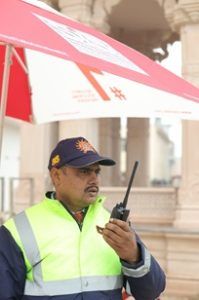
The role of technology in securing high-profile events is paramount, providing advanced surveillance, access control, and communication tools. Technologies like facial recognition, cybersecurity measures, and real-time monitoring systems enhance security protocols, ensuring a proactive response to potential threats. From crowd management to emergency response, technology is instrumental in safeguarding the integrity and success of high-profile events, offering a robust and integrated approach to security.
Brig Dwivedi revealed, “We implemented security technology to enhance the capabilities of our personnel and enhance the efficiency of our site operations. We integrated AI-based smart video analytics into more than 1000 CCTV cameras strategically positioned in and around the site. These cameras, in addition to other functionalities, were equipped with facial recognition capabilities designed to identify individuals with prior criminal records from within a crowd. This was achieved by comparing the faces of visitors with a database of known criminals in police records. The software also had the ability to conduct footfall analysis and detect incidents involving violence, ultimately aiding law enforcement.”
Furthermore, SIS provided its security personnel with body-worn cameras to ensure transparency and monitor the conduct of both staff and the public. The purpose of utilising these ‘bodycams’ was to discourage unprofessional, illegal, and inappropriate behaviour.
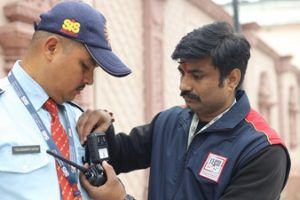
In addition, more than 100 Walkie-Talkie sets for wireless communication were distributed to personnel, along with two base radio station sets strategically placed in the Control Room to enhance operational efficiency. All security personnel were equipped with smartphones featuring the customised iOPS Application. Developed by SIS, iOPS serves as a digital reporting platform for managing the force and enables 24X7 tracking of team members. Beyond these functions, iOPS also addresses the crucial need for reporting potential risks and incidents that could impact the security and safety of the client.
Emergency Response: The Critical Aspect
Several NDRF teams, specialised in addressing chemical, biological, radiological, and nuclear threats, as well as disasters such as earthquakes, were mobilised for the large-scale event. The Ayodhya administration took proactive measures to address health emergencies, particularly in light of the intense cold wave gripping North India. Beds were allocated at hospitals in the city and district, as well as medical colleges in Ayodhya. Additionally, healthcare professionals received targeted emergency response training from specialists at AIIMS.
SIS Security teams, equipped with training in fundamental first aid and CPR techniques, were ready to lend assistance to the authorities in the event of any emergencies.
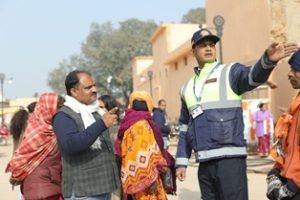
The Commitment Persists: Beyond Now
The narrative doesn’t conclude with the high-profile Pran Pratishtha ceremony on January 22nd; rather, it is just beginning now that the shrine is open to the public, and the special additional police force deployments are set to be withdrawn.
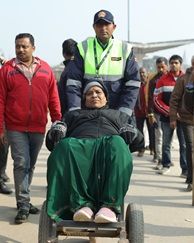
“Up until the events preceding January 22nd, SIS Security effectively managed the situation, providing comprehensive security cover for the Yagya and Ram Katha activities conducted under the guidance of Shri Ram Bhadracharya ji in Ayodhya from the 14th to the 22nd of January. Even during this period, marked by significant devotee attendance due to the ongoing ‘Yagya’ and ‘Langar Bhandaras’ (community free kitchens), the event was elevated by impressive cultural performances featuring actor and MP Hema Malini, Manoj Muntashir, and various other celebrities. SIS Security received universal acclaim for its services,” stated Brig. Dwivedi.
“However, the true value of the SIS Security team will be evident now. Following the Pran Pratishta on January 22nd, we had to deploy additional personnel to support the police in managing the unexpectedly large influx of devotees from January 23rd onward, when the darshan of Ram Lalla was opened to the general public. Approximately 500,000 devotees visited that day. Handling this was an enormous task, and the SIS team executed it exceptionally well,” he added.
Expanding Horizons: Navigating the Future
The proliferation of places of worship in India, coupled with the increasing recognition of the need for enhanced security, presents a significant opportunity for the private security industry. The recognition that police resources may be insufficient for adequate protection, there is a growing demand for specialised security services in this sector. Private security firms can seize this opportunity by offering tailored solutions that address the unique sensitivities associated with religious sites. Culturally sensitive approaches, understanding diverse religious practices, and collaborating with religious leaders are vital strategies for building trust and securing contracts.

Mr. V K Srivastawa, the Chief Operating Officer – Security Solutions says, “SIS has a history of providing security services at numerous religious places including the vast number of tourist sites under the Archaeological Survey of India on pan India basis.”
“SIS protects 43 religious sites with a deployment of over 1800 security personnel. Major temples where SIS is providing services are Mata Vaishno Devi in Jammu, Shri Thakur Banke Bihari Ji in Mathura, Shri Kainchi Dham in Nainital, Shri Maihar Devi in Satna, and Shri Kashi Vishwanath Dham in Varanasi. Over a period of time, SIS Group has acquired the required skills, training and management team, to deliver top class services at such religious places of national importance,” he disclosed.
“Apart from religious sites SIS also safeguards over 260 monuments of cultural heritage such as the Elephanta Caves, Kolaba Fort, Janjira Fort and Nagarjunakonda with a complement of over 3000 personnel,” he added
The challenge lies in striking a delicate balance between providing effective security measures and respecting the sanctity of these religious spaces. By investing in training programs on cultural sensitivity and staying adaptable to evolving threats, private security firms can navigate this landscape successfully, ensuring the safety of places of worship while maintaining a respectful and collaborative approach with the communities they serve.
Mr. Srivastawa expressed deep honour in being entrusted with the responsibility of securing the Ram Mandir. His statement underscores the commitment of SIS Group to maintaining the highest standards of security, ensuring the safety and sanctity of this revered site.
“For SIS Group, this association is not merely a duty; it represents a significant milestone in its mission to safeguard crucial cultural and religious institutions. SIS Group stands not only as a guardian of security but as a symbol of corporate commitment to preserving the cultural and religious aspects,” he added
With the successful culmination of the Pran Pratishtha ceremony in Ayodhya, SIS Group now eagerly anticipates collaborating closely with the other religious and cultural sites, reinforcing security measures, and contributing to the overall protection of other historic and sacred landmarks to preserve the rich heritage of India.



